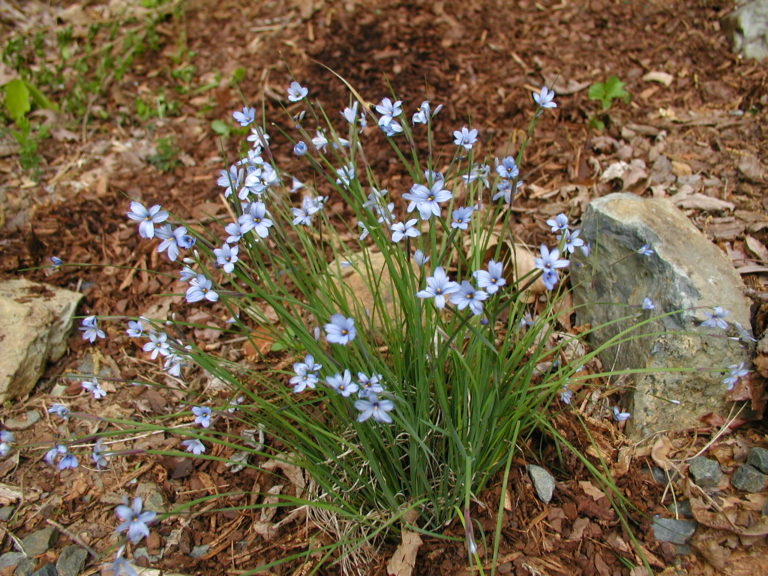Blue-Eyed Grass is a graceful and fetching herbaceous perennial in the Iris family which resembles a small bunch grass — until it flowers. Blue, 6-parted, with pointed tepals (petals and sepals) with golden centers, the distinctly not-grassy flowers are held on flattened, branched flower stalks just a bit above the straplike leaves. A small proportion, however, appear white. In nature it is found in meadows and on sunny roadsides in Eastern North America. A good early-season pollinator plant, Blue-Eyed Grass can be used to advantage along pathways, in borders, in rock gardens, and woodland meadows. It tolerates light shade, but full sun supports the most abundant flowering. It also tolerates some drought, but it prefers moist, well drained relatively lean soil and only shallow mulching. It is not a long lived perennial, but provides us with root sprouts to continue its delightful presence in the garden.
NURSERY HOURS
Wednesday: 10-4 Thursday: 10-6 Friday-Saturday: 10-4 Sunday: 12-4
Sisyrinchium angustifolium

Key Info
Scientific Name: Sisyrinchium angustifolium Mill.
Common Names: Blue-Eyed Grass, Narrowleaf Blue-eyed Grass, Bermuda Blue-eyed Grass, Stout Blue-eyed Grass, Pointed Blue-eyed Grass
Family Names: Iridaceae
Plant Type: Herbaceous perennial
Flower Color: Blue
Special Characteristics: Attracts bees, Attracts birds, Rhizomatous, Reported to be deer resistant., Tolerates drought
Additional Info
Habit: A clump-forming, perennial that features a loose tuft of narrow, grass-like leaves and slightly taller flower stalks supporting blue, star-shaped flowers, typically growing to 12" tall. The root system is coarsely fibrous, and can form new offshoots.
Height: 1'
Spread: 0.5 - 1'
Soil Conditions: Average moisture, well drained, organic, circumneutral pH, sandy, loamy, clay
Leaves: Narrow, grass like leaves to 3/16 inch, with parallel veins, about 12 inches long.
Flowers (or reproductive structures: Clusters of star-shaped, pale to bright, true-blue, scentless flowers to 1/2" across, each with 6 tepals (petals and sepals, when they look alike) and a yellow eye, are held a few inches above the leaves on branched, flattened flowering stems. Each petal or sepal has a tiny pointed tip often slightly notched on either side, and there are fine lines of dark violet radiating from the center of the flower, functioning as nectar guides. Flattened flower stalks arise from the leafy tufts.
Fruit: Wrinkled, brown 3-celled seed capsules split into 3 sections, releasing small black seeds; these can be carried a short distance by gusts of wind. Sept, Oct.
Natural Distribution: Moist meadows, damp fields, open woods and clearings, floodplain forests, sandy thickets, river banks, roadsides.
USDA Hardiness Zone: 5 to 9
USDA Wetland Indicator Status in NC: FACW
Pollination: Bees, butterflies, other insects.
Wildlife Connections: Blue-eyed Grass is a nectar and pollen source for pollinators (Halictine bees are the most frequent/likely visitors); provides cover for small animals; cardinals and other songbirds eat the seed; reported to be deer resistant.
Propagation: Blue-eyed Grass can be divided every few years, or they are propagated from seed.
